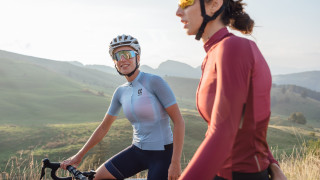Knowledge Level: Intermediate
It is not unusual during spring in Britain to experience all of the seasons in one ride. Getting your kit right can be hard, but follow these tips from Kalas, Great Britain Cycling Team Official On-Bike Clothing Supplier, for more comfortable, safer and enjoyable spring rides.
Base layer
Comfort begins next to your skin with a quality wicking base layer. This will draw chilling sweat away from your skin and some materials, such as Merino wool, will continue to insulate even when wet but not cause you to overheat if the sun comes out. The fit should be tight to facilitate the wicking process. A short sleeved baselayer, when combined with arm warmers offer more flexibility than long sleeved.
Jersey
With a quality base layer and a shell to put on and take off as the conditions dictate, you may find that a regular cycling jersey is adequate in the spring. A great alternative for mixed spring conditions is a membrane jersey though which offers both protection against the cold and wet but is more breathable than a typical shell. For hard riding in the spring, these can be ideal.
Lightweight shell
It’s always sensible to carry a lightweight wind-resistant jacket or gilet on spring rides. You can easily stash one in your jersey pocket and, although it might not keep you dry in persistent rain, it will certainly take the edge off on long chilling descents, during showers or if you have to stop for a mechanical.
Arm and leg/knee warmers
Spring kit is all about versatility and adapting to changing conditions and, for that, removable arm and leg warmers are impossible to beat. Stick them on for cool starts and then simply peel them off and stash them in your pockets when it warms up. Insulation varies from fully fleece lined to simple lycra and some also offer protection from the wind and rain. Fit is crucial and it’s essential for knee and leg warmers that they are well articulated around your knees and don’t restrict your pedalling.
¾ Length Bottoms
As an alternative to shorts with warmers or full-length tights, ¾ length bottoms will keep your knee joints protected. These are available in lycra or the more insulated Roubaix material. Also available in both fabrics with or without bibs.
Casquette/cap
Another super versatile piece of kit that will give you some insulation and protection in the cold and wet but also keep you cool if it warms up. The small peak helps to keep the rain out of your eyes and, if it gets really hot, you can just stow it in one of your jersey pockets.
Overshoes
Although you shouldn’t be battling cold feet in the same way as during the winter, lighter weight wind and water-resistant overshoes can still be a good idea during the spring. Even a simple Lycra covering will keep the vents of your shoes covered and your feet warmer and drier.
Thicker socks
For those days when overshoes might be a little too much, you could just try an extra thick sock. These double layer socks benefit from moisture removal and thermal insulation properties.
Gloves
If you suffer from cold hands, switching to mitts for mixed spring days probably isn’t an option but your winter gloves are probably just a bit too bulky. As long as they are windproof, you can get away with fairly thin long fingered gloves in surprisingly low temperatures. Neoprene gloves can also be really effective in mixed conditions. Once wet, they retain an insulating layer of water next to your skin, so they don’t need to be excessively bulky.
Dress to your ride
For shorter more intense sessions, such as intervals or hill reps, you can wear less and not worry so much about getting caught in a shower. Still take a gilet or lightweight windproof though to put on for warming up, cooling down and recovery intervals. The longer and less intense the ride, the more you need to think about long term comfort and layering flexibility.














